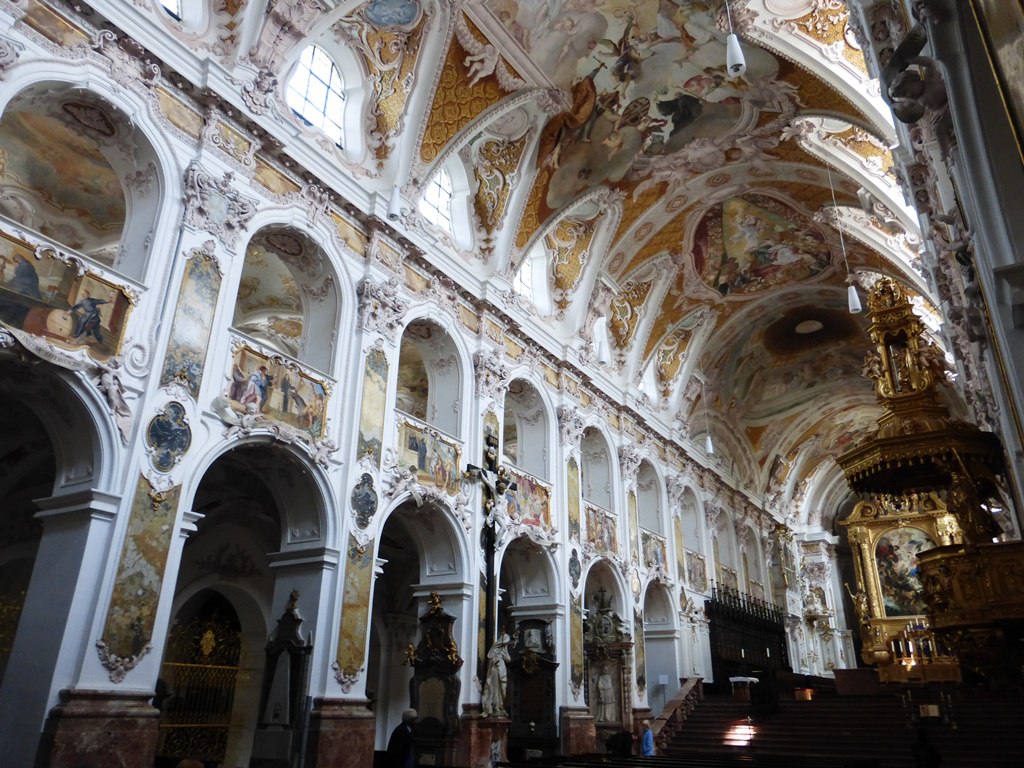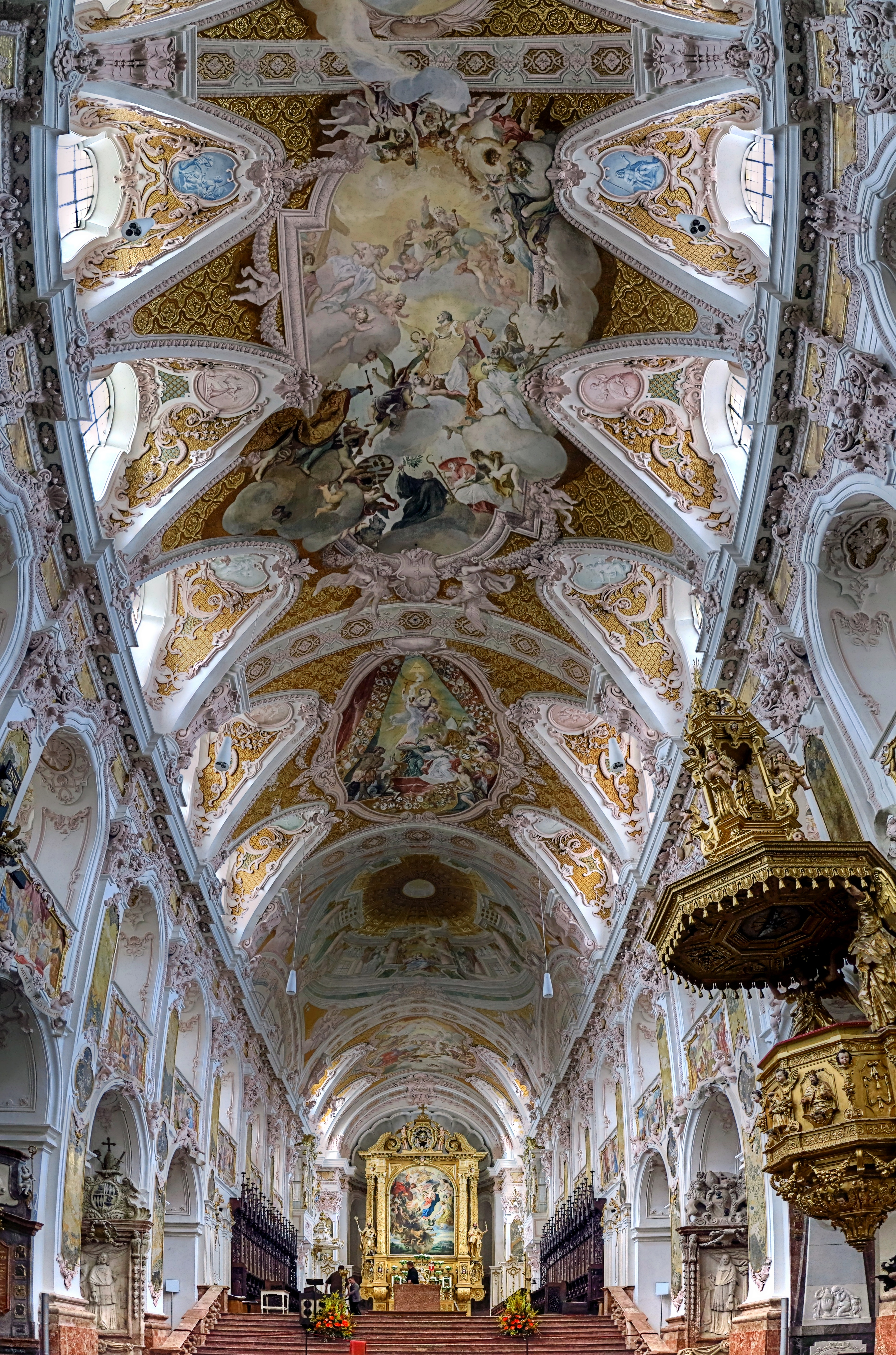Freising Cathedral
The Cathedral of St. Mary and St. Korbinian Freising - often shortened unofficially, also known as St. Mary's Cathedral - was cathedral and episcopal see of the former diocese of Freising, before the diocese moved 1821 as Archdiocese of Munich and Freising by Munich and the Liebfrauendom was elevated to a cathedral. At the instigation of the former Archbishop of Munich and Freising, Cardinal Joseph Ratzinger, Pope Benedict XVI of the former. , He has the rank of a co-cathedral. Here are the ordinations of today's Archdiocese will take place. The second patron of the Church, the Holy Korbinian is, at the same time the patron saint of the city of Freising and of the Archdiocese of Munich and Freising.
History
Already around 715 stood on the cathedral hill, the first Marian church of the diocese today, which was up by 739 Boniface as bishop church. To Bishop Anno 860 built a new three-aisled cathedral, renovated after fire 903. The current (third cathedral building ), plain from the outside, 78 m long five-aisle inside building with two towers, is of Roman origin and a new building was begun in 1159, partly using old components; Completion and consecration 1205. This replaces the. Due to a devastating fire on Palm Sunday, April 5, 1159 destroyed old church The cathedral was remodeled several times over the centuries.
The original Romanesque wooden flat ceiling was 1481 - 1483 replaced by a Gothic vault, which still exists today. In the course of the first Baroque style (from 1619), the Gothic ribs were removed. The renovation began for the 1,000 year celebration led to today's richly decorated rococo form, created about 1724, in less than one and a half years by the brothers Cosmas Damian Asam and Egid Quirin. The Asam brothers were based in the choice of colors for frescoes and stucco on the colors of the high altar painting, so that the impression of the room leaving behind a harmonious overall picture.
In the twenties of the 20th century, the frescoes were painted over in part by renovations. This color along with moisture led the frescoes to severe damage. This color layer was therefore chemically removed in the last full renovation (2006)
Pope Benedict XVI. studied from 1946 to 1951 when Joseph Ratzinger Toompea theology, was ordained a priest in the Cathedral and later worked as a professor of theology in Freising. On 14 September 2006, the Pope visited Freising Bavaria at the end of his journey and met the cathedral with the clergy.
Exterior
The towers were built of brick and partly of tuff. The North Tower is in contrast to the South Tower by two little paragraphs resulting from knocking off the Romanesque outlines, rejuvenated. His spindle-shaped rise is original. Remains of Roman arch friezes and pilasters were detected. They were eliminated in 1724, when the towers were painted. Regarding the absolute height above sea level ( and with only a few meters difference ), the cathedral towers with a height of 56 meters and its location on Cathedral Hill after the new transmission tower at Woodland Cemetery and the water tower on the Wehrenberg, but before the water towers of the brewery Weihenstephan and the 84 meter high tower of the parish church of St. George, the third tallest building in the city of Freising.
Equipment
Porch
The Slender- outdoor Portal ( 1681) with the niche figure of St. Korbinian is a beautiful Salzburg stonemasons and sculptors working in red Adnet marble, limestone. The lateral arches of the three-part lobby come from developed early Gothic ( 1314). On the left side altar painting by Johann Andreas Wolf " The Beheading of St. Katharina ", about 1699 / 1700's.
Under the late -Gothic vaults of the central nave of 1483 the mighty Romanesque main portal of the previous building stands ( created before 1190 ). On the main portal stone sculptures have been installed in the reconstruction of 1159. Links can be seen Frederick I Barbarossa, Emperor of the Holy Roman Empire, along with the Bishop of Freising and historian Otto of Freising ( his uncle ) and right Friedrichs wife Beatrix of Burgundy. Kaiser Barbarossa was also the patron of the reconstruction after the fire of 1159th Below the picture of Beatrix is a toad to see. A fertility symbol, which should provide rich blessing of children.
High altar
The present high altar was created in 1625 by Philipp Dirr and replaces the older Gothic high altar. The artist Peter Paul Rubens created in the years 1623-1625, the high altarpiece depicting the apocalyptic woman, in 1926 but replaced by a copy of Emil Boehm. The original painting is in the Munich Pinakothek. On the high altar picture you can see a vast storm of color and movement. In the middle you can see a woman (Mary), which the fierce battle of the Archangel Michael can be calmly done with the devil in the black evil cloud. Only her dress fluttering a little. With the most tender pressure of her foot she can hold the serpent of evil. The right side is fascinating brightly lit. From the bright side of cheer to her angel. With motherly pride she wears towards her child, the Saviour of the world, the heavenly father. At the bottom right of the screen also can be seen of the Freising Cathedral Hill.
For the high altar was - as in the Baroque usual - starting from the Council of Trent ( 1545-63 ) dispensed with the usual medieval tabernacle ( or African ) and added a tabernacle in the main altar itself. However, this is so far represents an art-historical particularity, as that the corresponding transfer of Trent for Episcopal churches did not apply.
Choir stalls
The cathedral has a Gothic choir stalls from 1488 with the Bishop series from the year 724 Each field has a different back panel jewelry.
Aisles
The church is run today fünfschiffig. In the northern area (inner aisle, to the east ) is the Blessed Sacrament Chapel with the Lamentation of Erasmus Grasser, created in 1492 ( side altar II). In the north outer aisle (Eastern final ) an altarpiece by Peter Candid 1626 "Mary visits her cousin Elizabeth ." In the south aisle apse, the Johann Nepomuk Chapel is located (page altar I). Quirin Asam Egid she created in the years 1737 and 1738 in the style of the late Italian Baroque. The three stucco figures on the altar, the three St. John represents ( the Baptist, the Evangelist and John of Nepomuk ). Hence the popular abbreviation Johannikapelle. The two outer aisles have evolved from small side chapels ( 14th and 15th centuries ), which were gradually added to the church, developed. Magnificent wrought-iron grille stretch out along between the outer and inner aisles. The gilt gratings are richly decorated and Freising work to 1630th
Organ
The case of the organ dates back to the instrument that is likely to have the 1624 Munich organ builder Hans Lechner built and not, as erroneously assumed Christoph Egedacher the Elder. The organ can be closed with two illustrated wing doors, centered at the top of a clock to see with Roman dial. On the wings of an angel concert and outside the Annunciation is shown inside. The present organ was newly created by the company 1978-1980 Winfried Albiez in Lindau and includes three manuals with 52 registers. It has the following disposition:
- Pairing: III / II, III / I, II / I, III / P, II / P, I / P
- Accessories: Coasters, sequencer
- Notes:
Crypt
The construction of the cathedral began construction of a Roman, vierschiffigen crypt, which is of particular importance. This was probably on September 2, 1161 already completed, as the relics of St. Nonnosus were buried in it in the presence of Archbishop Eberhard of Salzburg.
The vault of the crypt yoke for yoke by arched and is based on three times eight columns and two times eight half-columns, where the weight is distributed completely evenly. All columns and capitals of the crypt are individually designed. In the middle of the crypt, as if the center column, is the beast column from the 12th century, the only one of its kind in Germany.
In the crypt of the golden Korbinian shrine is kept. In addition, there is the Holy Lantpert.
Maximilian Chapel
The octagonal chapel was Maximilian east cultivated by Giovanni Antonio Viscardi 1710 the crypt as an extension. Stuck by Nicholas Liechtenfurtner, ceiling paintings of Hans Georg Asam. Among the niches mural in 1772 by Johann Baptist Deyrer. The altarpiece designed Andreas Wolff. The chapel also houses a small donated by Cardinal Friedrich Wetter reliquary with a relic of Blessed Kaspar Stangassinger.
Cloister
Just east of the Cathedral, the Gothic cloister connects; created in the 15th century and in 1716 new stucco work by Johann Baptist Zimmermann. In its north-eastern part of the cloister through the Benediktuskirche (14th century), in the south lies on the cloister of the Baroque Hall of the Cathedral Library ( 1732).
Bells
Main article: Freising Cathedral bells
The eleven bells of the Freising Cathedral were cast during the Renaissance and Baroque periods, as well as in 2007. The Freising Domgeläut is unique and represents an international cultural object first order
Gallery
On Cathedral Hill, overlooking the north tower
Ceiling frescoes
Ceiling frescoes
Freising Cathedral - shortly after the completion of the renovation: Perspective from the organ
Frederick I Barbarossa
Organ pipes
Shrine of St. Korbinian in the crypt
Grave of St. Korbinian in the crypt of the Cathedral of Freising
The large Korbinian bell hangs in a massive wooden belfry
Freising beast of northeast column
Beast column in the crypt of the Cathedral of Freising
Prince continuity between Fürstbischöflicher residence and Freising Cathedral










